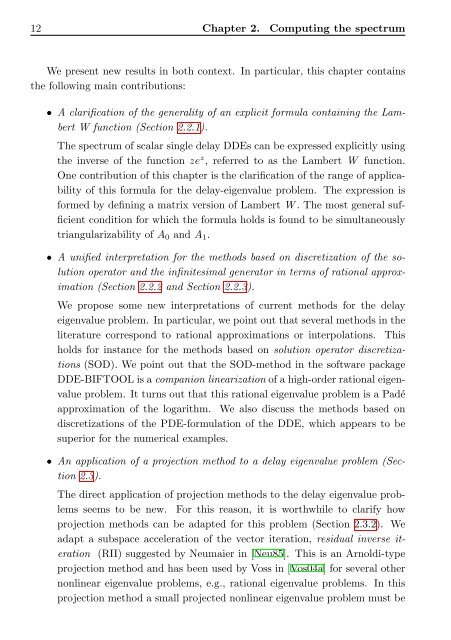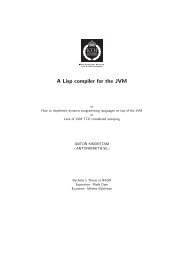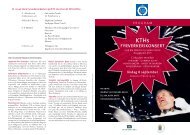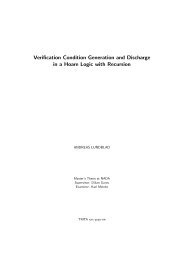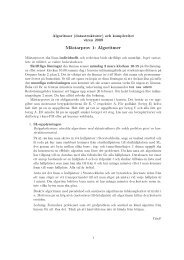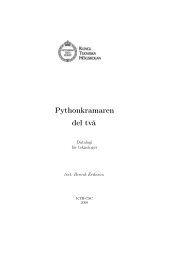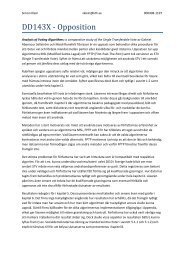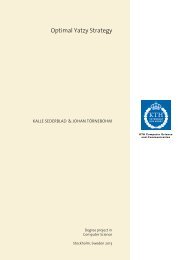The spectrum of delay-differential equations: numerical methods - KTH
The spectrum of delay-differential equations: numerical methods - KTH
The spectrum of delay-differential equations: numerical methods - KTH
You also want an ePaper? Increase the reach of your titles
YUMPU automatically turns print PDFs into web optimized ePapers that Google loves.
12 Chapter 2. Computing the <strong>spectrum</strong><br />
We present new results in both context. In particular, this chapter contains<br />
the following main contributions:<br />
• A clarification <strong>of</strong> the generality <strong>of</strong> an explicit formula containing the Lambert<br />
W function (Section 2.2.1).<br />
<strong>The</strong> <strong>spectrum</strong> <strong>of</strong> scalar single <strong>delay</strong> DDEs can be expressed explicitly using<br />
the inverse <strong>of</strong> the function ze z , referred to as the Lambert W function.<br />
One contribution <strong>of</strong> this chapter is the clarification <strong>of</strong> the range <strong>of</strong> applicability<br />
<strong>of</strong> this formula for the <strong>delay</strong>-eigenvalue problem. <strong>The</strong> expression is<br />
formed by defining a matrix version <strong>of</strong> Lambert W . <strong>The</strong> most general sufficient<br />
condition for which the formula holds is found to be simultaneously<br />
triangularizability <strong>of</strong> A0 and A1.<br />
• A unified interpretation for the <strong>methods</strong> based on discretization <strong>of</strong> the solution<br />
operator and the infinitesimal generator in terms <strong>of</strong> rational approximation<br />
(Section 2.2.2 and Section 2.2.3).<br />
We propose some new interpretations <strong>of</strong> current <strong>methods</strong> for the <strong>delay</strong><br />
eigenvalue problem. In particular, we point out that several <strong>methods</strong> in the<br />
literature correspond to rational approximations or interpolations. This<br />
holds for instance for the <strong>methods</strong> based on solution operator discretizations<br />
(SOD). We point out that the SOD-method in the s<strong>of</strong>tware package<br />
DDE-BIFTOOL is a companion linearization <strong>of</strong> a high-order rational eigenvalue<br />
problem. It turns out that this rational eigenvalue problem is a Padé<br />
approximation <strong>of</strong> the logarithm. We also discuss the <strong>methods</strong> based on<br />
discretizations <strong>of</strong> the PDE-formulation <strong>of</strong> the DDE, which appears to be<br />
superior for the <strong>numerical</strong> examples.<br />
• An application <strong>of</strong> a projection method to a <strong>delay</strong> eigenvalue problem (Section<br />
2.3).<br />
<strong>The</strong> direct application <strong>of</strong> projection <strong>methods</strong> to the <strong>delay</strong> eigenvalue problems<br />
seems to be new. For this reason, it is worthwhile to clarify how<br />
projection <strong>methods</strong> can be adapted for this problem (Section 2.3.2). We<br />
adapt a subspace acceleration <strong>of</strong> the vector iteration, residual inverse iteration<br />
(RII) suggested by Neumaier in [Neu85]. This is an Arnoldi-type<br />
projection method and has been used by Voss in [Vos04a] for several other<br />
nonlinear eigenvalue problems, e.g., rational eigenvalue problems. In this<br />
projection method a small projected nonlinear eigenvalue problem must be


